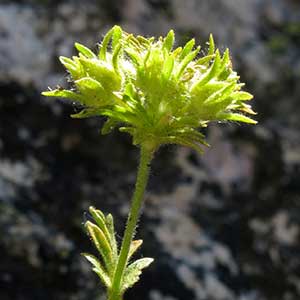Ivesia longibracteata
Ivesia pityocharis
Castle Crags ivesia, longbract mousetail
pine nut mountain mousetail, pine nut mountains ivesia
ascending to erect, 0.3–1.2 dm.
prostrate-decumbent to ascending, 0.5–2(–3) dm.
weakly planar to loosely ± cylindric, (0.5–)2–4(–6) cm; sheathing base glandular abaxially, otherwise glabrous;
petiole 0.5–2 cm, hairs 0.2–1 mm;
leaflets 5–6 per side, 2–6 mm, ± short-hirsute, glandular-puberulent, lobes 2–7, oblanceolate to spatulate or obovate, apex not setose.
6–12(–15) cm; sheathing base weakly strigose abaxially;
stipules absent;
petiole (1–)1.5–2.5(–3) cm, hairs abundant, ascending to spreading, 1–4 mm;
leaflets 15–25 per side, loosely overlapping, (1.5–)2–7 mm, lobes 0–4(–6), lanceolate or oblanceolate to elliptic, hairs abundant, spreading to ascending, 1–3 mm.
1–3, not paired.
2–5.
3–14-flowered, 1–2.5 cm diam.;
glomerules 1.
(7–)15–50-flowered, 2–8 cm diam., flowers arranged individually and/or in several to many loose few-flowered glomerules.
1.5–6 mm.
(3–)6–15(–22) mm.
8–10 mm diam.;
epicalyx bractlets linear to narrowly lanceolate or elliptic, 2.5–5 mm, longer than sepals;
hypanthium shallowly cupulate, 0.5–1 × 2–3 mm;
sepals 1.5–2.5 mm, ± acute;
petals pale yellow, linear to narrowly oblanceolate, 1.5–2.5 mm;
stamens 5, filaments 0.7–1.3 mm, anthers yellow, 0.5–0.8 mm;
carpels 6–11, styles 1–1.5 mm.
8–13 mm diam.;
epicalyx bractlets lanceolate to elliptic, 2–3 mm;
hypanthium patelliform to shallowly cupulate, 1.5–2.5 × 3–4.5 mm, ± 1/2 as deep as wide;
sepals often purple-suffused, 2.3–4(–5) mm, acute;
petals white, broadly spatulate or obovate to orbiculate, (2.8–)3–5(–6) mm;
stamens 20, filaments filiform, (1–)1.5–3 mm, anthers light pink, 0.3–0.5 mm;
carpels 8–20, styles 2.2–3 mm.
cream to light tan, 1.2–1.5 mm.
light brown, 1.2–1.3 mm.
Ivesia longibracteata
Ivesia pityocharis
Of conservation concern.
Ivesia longibracteata is known only from the Castle Crags area of Shasta County. The epithet alludes to a diagnostic characteristic unique in the genus: the epicalyx bractlets are longer than the sepals. The plants grow on vertical rock faces, a habitat more characteristic of sect. Setosae; however, the stems are ascending to erect and do not form hanging clumps, and the pedicels are not curved in fruit.
(Discussion copyrighted by Flora of North America; reprinted with permission.)
Of conservation concern.
Ivesia pityocharis is known only from the Pine Nut Mountains, Douglas County. Plants are somewhat intermediate between those of I. kingii and I. sericoleuca in having relatively shallow hypanthia and loosely sericeous vestiture. Hairs on petioles and stem bases of I. pityocharis are to 4 mm; those of I. kingii are 1 mm and generally appressed-ascending.
(Discussion copyrighted by Flora of North America; reprinted with permission.)


